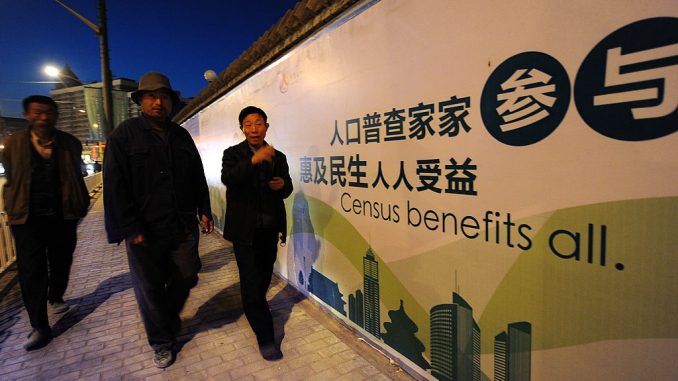

The Chinese Communist Party (CCP) has again delayed the release of the 2020 census results. Demographers suggest that China is already experiencing negative population growth. An expert speculates that, in addition to natural factors, the sharp decline in population may be linked to the pandemic, and that the CCP needs time to massage the real figures.
The seventh population census of China was completed in early December 2020. In March, China’s National Bureau of Statistics (NBS) said that the census results would be released in early April.
However, on April 16, the NBS announced that in order to provide more details, more preparation was needed. “We will accelerate our work to the next step, and we strive to release the final results of the census as soon as possible,” the NBS stated.
On April 29, the NBS published a one-sentence report that said, “In 2020, China’s population continues to grow, and specific data will be published in the 7th National Census Bulletin.”
The “specific data” has yet to be released.
Demographer: China’s Population Less Than 1.28 Billion
As early as Nov. 16, 2020, Yi Fuxian, a well-known demographer and author of the book “Big Country with an Empty Nest,” said in a post on Twitter that in his “2020 Census Simulation Study” published in the Social Science Forum, he projected the actual population of China in 2020 to be about 1.26 billion, and doesn’t likely to exceed 1.28 billion, and is even less likely to reach the officially announced 1.4 billion in 2019.
He said that “China’s policies are all based on faulty demographic data. After [China] enjoyed the status as the world’s most populous country for thousands of years, that title was taken by India a few years ago.”
By the end of 2016, India’s population had reached 1.326 billion, or 18 percent of the world’s total population.
Sharp Decline in Newborns
A report released on April 29 cites data from the Ministry of Public Security of the CCP, which indicates that only 10 million newborns were registered in China in 2020, a significant drop of about 15 percent from 2019.
In 2019, the number of newborns registered by the Ministry of Public Security was 80.5 percent of the birth number recorded by the Bureau of Statistics. If the same ratio is used to calculate the birth number of 2020, that will result in a decline of over 2 million births in 2020 compared to 2019.
China’s NBS announced on Jan. 17 that China’s total population was 1.4 billion at the end of 2019, an increase of 4.7 million from the end of the previous year.
However, the report, titled “China Population Report: Births in Many Places Fall by 10–30 Percent,” states that China is unlikely to reach the 1.4 billion population goal in 2020 as projected in the National Population Development Plan (2016–2030).
The report’s author, Soochow Securities chief economist Ren Zeping further suggests that data from the Information and Statistics Center of the Beijing Municipal Health Commission show that the number of registered household births in Beijing in 2020 was only 100,000—24.3 percent less than in 2019.
Beijing Think Tank: Drop in Births Recorded in Many Cities
Data collected from various regions by the Beijing-based think tank Center for China & Globalization (CCG) show that the number of births in Wenzhou city dropped by 19 percent in 2020 compared to 2019, Hefei city by 23 percent year-on-year, Guangzhou city by 9 percent, Yinchuan city by 12 percent, Taizhou city by 33 percent, and Pinghu city by 21 percent.
Furthermore, in the first half of 2020, the population fell 19 percent year-on-year in Ningbo city, Zhejiang Province, and 26 percent in Weifang city, Shandong Province.
From January to July 2020, the population of Huangshan city in Anhui Province, fell 17 percent.
From January to September 2020, the population of Guiyang city, Guizhou Province, fell 32 percent year-on-year.
The CCG speculated that “there is no doubt that the number of births in China in 2020 was significantly lower than in 2019,” and that “given that the number of women of childbearing age in China will continue to decline and that fertility intentions are likely to remain low, we can say that although the number of births in 2020 will be the lowest in recent decades, it is likely to be the highest in the next few decades.”
The CCG called for a change in the fertility policy to fully liberalize and encourage autonomous fertility.
China’s Central Bank Signals to Fully Lift Restrictions on Birth Control
On April 14, China’s Central Bank published a paper called “Understanding and Responses to Demographic Transition.” The paper reveals that when compared to developed countries, China’s population is aging more rapidly and families are having fewer children.
The paper states that China’s demographic situation has changed, and it’s difficult to compensate for the population decline with education and technological advances, so the government shouldn’t impose any more birth control and people should be encouraged to have children.
Ren published another report on April 16 with two other authors on China’s fertility entitled “Aging and Childlessness are Accelerating and a Complete Lifting of Restriction on Birth Control is Urgently Needed.”
In another report published by Ren, he states that the aging population and fewer children are the biggest dangers that are being ignored in China. The April 16 report, titled “Aging and Childlessness are Accelerating and a Complete Lifting of Restriction on Birth Control is Urgently Needed,” he recommends an immediate and full lifting of restrictions on birth control to encourage childbirth.
In his recently released population report, Ren said that both quantity and quality of population affects the power of the nation. People are not only consumers, but also much needed manpower. A large population creates a large market on the demand side and provides sufficient labor and more talent on the supply side. Therefore, a large population is a national advantage, not a disadvantage.
He said a significant reduction in population would lead to the shrinkage or even extinction of a large number of cities and the disappearance of a large number of industries, which would seriously damage national power.
Delay of Data Release May be Related to Pandemic Death Tolls
The extended delay in the release of census data has caused concerns.
“This matter does look strange. On the one hand, the NBS claims that the population continues to grow, but on the other hand, the Central Bank advocates for full lifting of restrictions on birth control. Also, the CCP authorities have not blocked the reports about the declining birth numbers in 2020 released by leading economists and think tanks,” U.S.-based China expert Li Yanming told The Epoch Times.
Li said that all these factors indicate that the census data will certainly not be good.
He believes that while the decline in births in 2020 may be one reason for the decline in the total population, the bigger reason may be the high number of deaths in the 2020 pandemic.
“It is hard to estimate how many people have died last year because of COVID-19,” he said.
According to a report released by China’s Ministry of Industry and Information Technology on March 19 last year, the number of cell phone subscribers of China’s three major telecom operators (China Mobile, China Unicom, and China Telecom) dropped by 21 million in the first two months of 2020.
The first two months of 2020 was also the time when the pandemic was at its peak in Wuhan, with both hospitals and crematoriums overwhelmed.





Be the first to comment